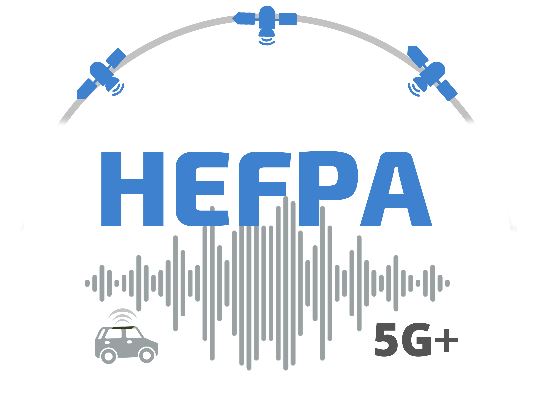A project within the EUREKA PENTA program
Paris, September 15, 2020 – HEFPA (Highly Efficient and Flexible Phase Arrays), a project within the PENTA program, is developing IP and components that will reduce the complexity of building ‘phased array antennas’. These are the electronic components required to receive and transmit radio waves in Satcom and 5G mmWave (millimeter Wave) mobile and infrastructure devices. In addition, the HEFPA components will boost energy efficiency, reducing consumption by 30% compared to existing solutions.
Think of downloading a full-length movie onto your phone in seconds or of a specialist surgeon using robotic arms to carry out a life-saving operation on a patient in another remote city by leveraging satellite communications. 5G (fifth generation) telecommunications and Satcom systems that will leverage the mmWave portion of the spectrum promises to turn such scenarios into reality. Industries and consumers will benefit from applications and services enabled by the Internet of Things (IoT), Artificial Intelligence (AI), Virtual and Augmented Reality (VR & AR) – from more energy-efficient manufacturing to personalized medicine, truly immersive entertainment, self-driving cars and more.
5G services currently being rolled out in Europe and elsewhere are based on updated 4G systems. In addition, a host of Low-Earth Orbit Satellite constellations are now in deployment that will leverage ubiquitous coverage between the north and south poles. However, the biggest gains will come from the introduction of new mmWave technologies, which use radio waves of much higher frequencies and shorter wavelengths. These technologies are the real key to improved network capacity, faster downloads (anywhere from 10 to 100 times) and reductions of up to 10-fold in ‘latency’ (i.e. the time to respond to an instruction or a command). Moreover, mmWave will leverage highly directional signal that can be steered to track moving objects with much reduced signal interference compared to sub-6 GHz frequency bands.
However, mmWave presents challenges. The RF signals experience higher path loss as they travel and are easily blocked by buildings, people and objects. New antenna technologies with ‘beam forming’ which focus signals in the direction of the intended user can overcome these limitations and deliver the full potential of 5G and Satcom applications. The HEFPA project aims to provide system integrators and product developers with a quick and flexible way to build such phased array antennas – with the further benefit of increased energy efficiency.
Bringing together an ecosystem of partners with experience in RF ICs (radio frequency chips), RF systems, chip packaging and PCBs (printed circuit boards), HEFPA will develop its modules for use in consumer user equipment. Current consumer grade mobile and WiFi markets account for over a billion radio systems a year, and mmW enablement in various RF communications subsystems is expected to reach 100 M units per year in 2022. An even larger market is anticipated for VR/AR systems that leverage mmW technology. Thus, HEFPA has major commercial potential, as well as playing its part in Europe’s ambition to be a global leader in leveraging mmWaves as a strategic technology for the digital economy and society.
About the PENTA program
 PENTA is a EUREKA cluster whose purpose is to catalyze research, development and innovation in areas of micro and nanoelectronics enabled systems and applications – where there is shared national and industrial interest. Based on the Electronic Components & Systems (ECS) Strategic Research Agenda (SRA) key areas and essential capabilities, PENTA program contributes to the development of electronic solutions with the opportunity for rapid competitive exploitation and a strong impact on European societal challenges. The PENTA project team is supporting SMEs, large corporations, research organizations and universities by facilitating access to funding, fostering collaborative work and creating consortia.
PENTA is a EUREKA cluster whose purpose is to catalyze research, development and innovation in areas of micro and nanoelectronics enabled systems and applications – where there is shared national and industrial interest. Based on the Electronic Components & Systems (ECS) Strategic Research Agenda (SRA) key areas and essential capabilities, PENTA program contributes to the development of electronic solutions with the opportunity for rapid competitive exploitation and a strong impact on European societal challenges. The PENTA project team is supporting SMEs, large corporations, research organizations and universities by facilitating access to funding, fostering collaborative work and creating consortia.
PENTA is operated by AENEAS.
More on PENTA: http://www.penta-eureka.eu
More on AENEAS: https://aeneas-office.org
About HEFPA
 HEFPA is an RD&I project consortium involving 7 partners from 2 countries, Canada, and the Netherlands. The project partners are: NXP Semiconductors Netherlands BV (project coordinator), C-COM Satellite Systems Inc., Carleton University, Eindhoven University of Technology, Semiconductor Ideas to the Market (ItoM) BV, Skyworks Solutions Canada Inc., and University of Waterloo.
HEFPA is an RD&I project consortium involving 7 partners from 2 countries, Canada, and the Netherlands. The project partners are: NXP Semiconductors Netherlands BV (project coordinator), C-COM Satellite Systems Inc., Carleton University, Eindhoven University of Technology, Semiconductor Ideas to the Market (ItoM) BV, Skyworks Solutions Canada Inc., and University of Waterloo.
More on HEFPA: Link to be communicated when the Project Profile is approved
